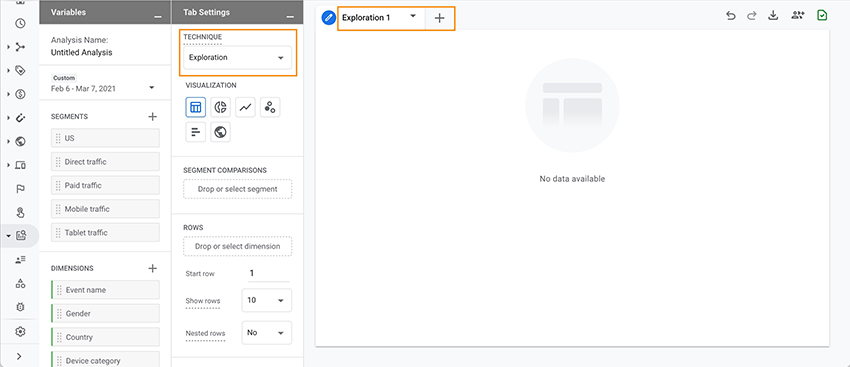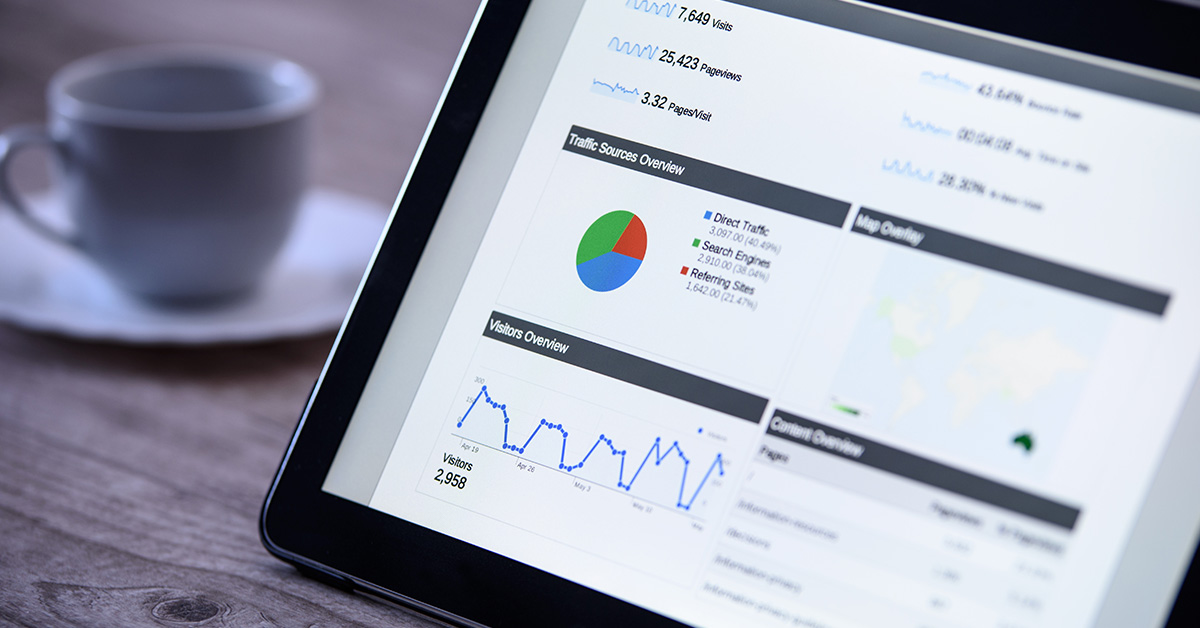Google Analytics 4 (GA4) is Google’s newest version of Google Analytics. Google announced Google Analytics 4 as the standard for all new Google Analytics properties on October 14, 2020. Previously known as Web + App Property, Google Analytics 4 is Google’s answer to its announced end of support for third-party cookies.
While Google Analytics 4 doesn’t replace Universal Analytics (UA) (known as Google Analytics by most of today’s users), Google will no longer do new development on UA. That means that at some point, most website managers will want to migrate to Google Analytics 4. The question is how do the two platforms compare and when should you switch?
How Does Google Analytics 4 Compare to Universal Analytics?
Compared to Universal Analytics, Google Analytics operates on a completely new philosophy, has a different interface, uses different tracking logic, and offers different standard reports and parameters.
GA4 tracks users instead of the user sessions tracked by UA. GA4 also combines website data and app data into a single data set. That combination lets you compare data across the platforms, which makes it easier to analyze and compare.
Google Analytics 4 is virtually future-proof because it supports cookie and cookieless tracking. It offers modeling capabilities to let digital marketers understand and track user behavior without relying on cookies. No doubt, it will support the upcoming interest-based advertising (FLoC) approach.
GA4 won’t be total without access to cookies though (at least until they’re gone). By using filters for the corresponding sources within the available standard analysis or in specially created custom reports, you can still track users from sources, such as Facebook. And you can still track which campaign led a user to your site and, if applicable, converted.
Google Analytics 4: Advantages and Disadvantages Compared to Universal Analytics
The advantages of Google Analytics 4 include that it:
- Is future-proof because it enables data collection without cookies
- Measures multiple events by default, including page views, scrolling, clicks on external links, website search, video engagement, and file downloads
- Supports added conversion goals, which are easily activated and deactivated as events
- Runs on a machine learning algorithm
- Offers conversion modeling, which is crucial in a world without cookies
- Anonymizes IP by default and excludes bot traffic
The disadvantages of Google Analytics 4 include that it:
- Supports only first-click attribution and last-click attribution
- Only offers connections to Google Ads and BigQuery, but has no connection to Google Search Console currently
- Is currently missing some features users valued and used extensively, including:
- Individual channel grouping
- Filter opportunities for internal traffic
- Referral exclusion list (which is crucial for reporting checkouts, for example with PayPal)
- Supports fewer default reports and has no custom reports; it does offer an Analysis option with templates, but it takes time to set up your analysis as desired (There is a workaround using Google Data Studio.)
Key Differences Between Google Analytics 4 and UA
Events vs User Sessions in GA4
Data in GA4 is based and collected solely on events rather than user sessions. An event is “any distinct action occurring at a distinct time associated with a user in your app or on your website.” GA4 collects data for multiple automatically-collected events based on how a user interacts with your site in any number of nuanced ways, which gives you more detailed information on user behavior than is available in UA.
While the shift will take time to get used to, it also creates opportunities to collect better, more insightful data about site visitors.
Default Events
Pageviews is one of the default events in Google Analytics 4 and is collected as an event called page_view.
Each automatically-collected event in Google Analytics 4 can be deactivated manually if desired. With this change, some events are recorded automatically that have to be created manually in UA. This helps reduce the effort to set up the new property.
Other available event categories include enhanced measurement, recommended (vertical-specific), and custom (named and implemented).
All events in GA4 include five parameters whether automatically collected or custom events:
- Language
- Page_location
- Page_referrer
- Page_title
- Screen_resolution
Custom Events
Custom events can be set up to capture additional data. This can be done directly in the GA4 property or in Google Tag Manager. Custom events give you more detail in GA4 than they do in UA because events in GA4 aren’t limited to predetermined parameters, such as category, action, label, or value.
In addition to the predefined parameters for all events in GA4, you can define your parameters to use in custom events and for analysis. This gives you access to more than the four parameters available for custom events in UA.
Google Analytics 4 also measures conversions as conversion events, which makes defining conversions easier than with UA.
There are no limits for data collection and configuration in GA4 are less restrictive than in UA. In Universal Analytics, you have to create goals manually. In Google Analytics 4, all you have to do is activate events as conversions. Up to 30 conversions can be activated and deactivated (if necessary) in GA4.
Engagement Rate Replaces Bounce Rate In Google Analytics 4
Many digital marketers use bounce rate to determine whether website visitors have engaged with a website. This carries the risk of misjudging page performance. Especially since user interaction with a product page differs from say that of a blog post.
In GA4, Google replaces the bounce rate with the engagement rate as a new metric.
User engagement with a page during a session is tracked in Google Analytics 4 instead of whether or not the user simply bounces from the page if at least one of these conditions is met:
- At least 10 seconds of active foreground interaction with the website or app
- The trigger of a conversion event
- Visit two or more pages
Engagement rate is calculated by dividing engaged sessions by the total number of sessions. Engagement rate is basically the inverse of bounce rate and lets you better understand user engagement with your website.
Think of a visitor who comes to your site to read a blog post and then leaves — a valuable interaction that’s mislabeled when seen solely as a bounce. Rather than seeing the visitor as a bounce, in GA4, you can now see the visitor’s engagement and have better insight into how the user is interacting with your site overall.
eCommerce Changes in Google Analytics 4
Google Analytics 4 makes significant changes to the structure and naming for events and parameters for eCommerce. If you have eCommerce set up through Universal Analytics on your site, be aware of the changes so you can continue collecting eCommerce data in GA4. And know that you’ll need to make potentially time-consuming changes to your data layer to start collecting eCommerce data in GA4.
The biggest change is to the purchase event. But, the checkout event or the product dimensions are changed or renamed too. You want to adjust those when implementing or upgrading eCommerce tracking for Google Analytics 4.
To Migrate to GA4 Now or Not?
Google has ended development on Universal Analytics, so it has no long-term future. But many features used by marketers in UA aren’t yet available in Google Analytics 4. And even though there’s no question that GA4 is the future, should you migrate?
Using only GA4 right now, doesn’t make sense. Instead, create a new GA4 property and run both Google Analytics 4 and Universal Analytics in parallel. This way you can familiarize yourself with the new data model and set up initial goals and analysis and be ready as your data builds and as GA4 fully matures.
Things to Know About Setting Up Google Analytics 4
When you move to Google Analytics 4, a new property is created and you won’t have access to any data until you add the GA4 tracking code to your website. Data from your existing Universal Analytics property won’t be migrated into GA4.
Define Goals and the Data You Want
GA4’s focus on data collection, its new tracking logic, fewer standard reports, and the need to create custom analysis reports, makes it crucial to define the goals that are important to you in your GA4 property.
To analyze and evaluate the data available to you in GA4 effectively, you want to start with a strategy and KPIs. The ability to apply more user-defined parameters per event makes it essential to understand what data you want to collect.
You can set up event tracking directly in Google Analytics or with Google Tag Manager. Ensure that you use event names consistently. Consistent naming means consistent data.
Defining events is important, but parameters are an important tool too. It doesn’t matter whether you use custom or predefined parameters. Know that GA4 does limit you to 50 event-based and 25 user-based custom parameters. And user-based parameters have to be defined in GA4.
Decide What Data Matters
If you’re currently using Universal Analytics, you’ve already defined goals and events to evaluate engagement and performance. Many of these goals from Universal Analytics aren’t needed in Google Analytics 4.
By default, in GA4 activated events provide needed basic data, such as engagement, page views, or clicks. So when using GA4, you want to instead focus on more in-depth information and which user actions are important to you. This can include contact requests, purchases, and so on. In some cases, even micro-conversions can help you get a better understanding of how users interact with your website.
It’s a challenge to meet all requirements, so a structured approach is essential. Little things, like including the value and currency parameters for all events and not just transactions, can help you get the most of your data. The right parameters can even give you insights into the value of new leads or contact requests for specific products or services.
Once You Know What Data You Want, Do Analysis
Analysis in GA4 provides advanced visualization and analysis opportunities beyond its standard reports. Once you integrate GA4 into your website and start collecting data according to your tracking strategy, consider using Analysis templates in addition to the predefined standard reports and analyze your data immediately.
You can use Analysis to create your analysis templates to analyze funnels, segments, paths, users, cohorts, and more with pivot tables, scatter plots, or acquisition and conversion reports.

An analysis template set to the default exploration option in Google Analytics 4.
You can combine different items in a single template or use different tabs for each type of analysis. Note, it takes time to create templates in GA4. It’s time well spent however as you’ll end up with the data you want for analysis and reporting available to you and anyone you share reports with.
Migrating If You Have eCommerce Data
In terms of eCommerce data, migrating is more complicated. The development of GA4 is ongoing and many functions in UA aren’t yet available. Because collecting eCommerce data in GA4 requires changes to the data layer, there’s no way to collect eCommerce data in both versions in parallel.
Changes required in GA4 for eCommerce include creating data layer events in GA4, adjusting existing tracking for Analytics, Facebook, and/or Google Ads Conversion tracking if value variables, such as transaction value, change.
Event parameter mappings are different in Google Analytics 4 and items that were automatically mapped in Universal Analytics have to be manually added in GA4 as event parameters for the purchase event. While initially a time-consuming task, once done, you’ll have access to more options in how you pull data.
This doesn’t mean that you shouldn’t implement Google Analytics 4 at all. As for your overall site, do both versions in parallel. Continue collecting eCommerce data in Universal Analytics as your primary tool. Also start recording basic data, such as page view events, user engagement, and so on in GA4, to familiarize yourself with the new interface. This way you’ll have data to work with when GA4 is fully mature.
Key Takeaways on GA4
- It’s the future of analytics for Google products
- It offers stronger insights into customer behavior than you get with UA
- It’s important to make decisions on which KPIs are valuable for your business and start collecting data — don’t forget to track your KPIs!
- It’s a good idea to start using it now, but don’t abandon UA yet — use both
About the Author
Ralf Guggeis is CEO of twofour digitale Agentur based in Rosenheim, Germany. He and his team have helped brands and corporations with all aspects of marketing and digital marketing — from business consulting to building powerful eCommerce infrastructure and print and TV commercials as well digital campaigns — for more than 20 years.





